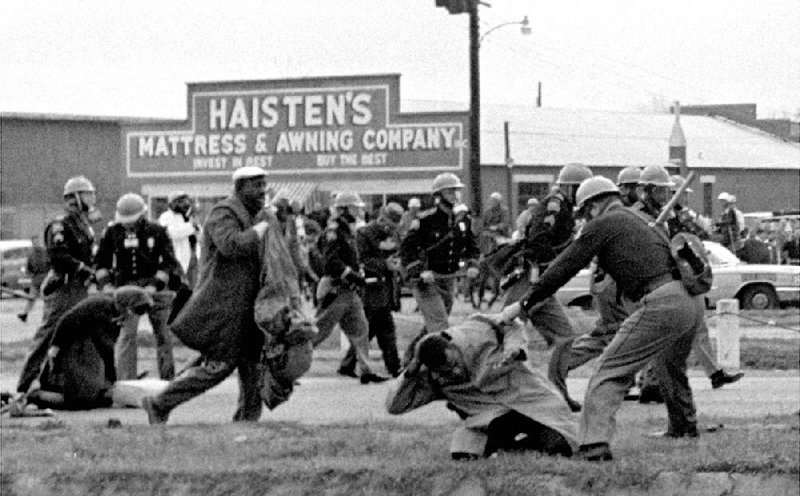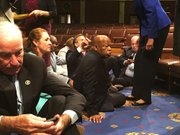WASHINGTON -- The full-fledged revolt on the floor of the U.S. House began in the same way many of the protests engineered by U.S. Rep. John Lewis were launched: quietly, resolutely and in the face of long odds.
The chamber was partway through a comatose daily ritual of mundane speechifying known as "morning hour" June 22 when a gaggle of House Democrats gathered at the podium in the well of the chamber and refused to move.
At their center was Lewis, whose savvy in orchestrating sit-ins made him one of the most effective foot soldiers of the civil-rights movement. Here he was again, leading an outnumbered group bristling at the restrictions of a body dominated by majority rule, at the helm of a different sort of fight.
A tussle over gun restrictions in the aftermath of the June 12 Orlando, Fla., massacre does not hold a candle to the centuries-long struggle over civil-rights equality in America. And Lewis' critics maligned his tactic, which ultimately failed to force a vote, as a cheap publicity stunt that traded on his history.
But, for the 76-year-old Lewis, it was a return to his roots.
"Sitting there on the floor, I felt like I was reliving my life all over again," said the Atlanta Democrat beaming to reporters late that day. "During the '60s the sit-ins started with three or four people, and they spread like wildfire. This will spread."
The House protest was fluid, but it was not impromptu. It was planned over the course of several days by Lewis and more than a dozen of his political allies, and it soon ballooned to incorporate virtually every member of the Democratic caucus.
The main goal was to force the chamber's GOP leaders to agree to hold votes before the July Fourth recess on two bills the Senate had already rejected earlier that week: one that would expand background checks for gun purchases and another that would bar people on the government's terror watch list from buying firearms.
Amid vocal opposition from gun-rights groups such as the National Rifle Association, Republicans held their ground. They dismissed the sit-in as a "publicity stunt," in the words of House Speaker Paul Ryan; a breakdown in House decorum; and a hissy fit by cranky Democrats who lacked the votes to win outright.
"The reason I call this a stunt is because they know this isn't going anywhere," Ryan said. "It already failed in the Senate."
The sit-in rubbed some of Lewis' Georgia colleagues the wrong way, too. Republican Rep. Lynn Westmoreland prefaced his criticism of Lewis like many did -- by calling him a "great guy," a "very good friend" and a champion for civil rights.
"But we've got differences of opinions on how to try and get our message across," said Westmoreland, who participated in a 2008 House floor protest over offshore drilling when his party was in the minority. "To do it on the House floor, to me, was I think just taking it a little bit too far," he said.
Republicans ultimately denied the Democrats' request. Ryan in the wee hours of June 23 adjourned the chamber for its July Fourth recess.
But Democrats did secure a consolation prize: increased public interest and attention thanks to their runaway social media campaign. Party members vowed to fight on in their districts and in Washington but were vague about what exactly would come next. What's clear is the pressure won't die down.
"We will continue to meet and talk during the next few days," Lewis said in an interview with The Atlanta Journal-Constitution. "I think there will be some direct action moving forward."
"We cannot stop until we get a bill, until a law is passed," said House Minority Leader Nancy Pelosi of California.
The party's 26-hour takeover of the House floor had little modern precedent and shocked even the most seasoned and jaded of Washington hands.
It spanned from the solemn -- speeches that simply listed the names and ages of the Orlando victims -- to the surreal, punctuated when dozens of Democrats stormed the well of the House during a late-night vote, chanting "no bill, no break" at their Republican colleagues, drowning out Ryan as he sought to reassert control of the chamber.
In other words, the events were not unlike the protests of Lewis' youth. But instead of sit-ins protesting segregation and racial inequality, the civil disobedience this time was sparked by the lack of congressional debate and votes on stricter gun measures in the wake of one of the largest mass shootings in modern U.S. history.
"I've been here for almost 30 years," Lewis told C-SPAN. "To see members occupy the well of the House -- by sitting down they're really standing up for the very best in the American tradition."
Lewis first rose to public attention in the civil-rights movement in 1963 as chairman of the Student Nonviolent Coordinating Committee, but it was three years earlier in Nashville, as a college student, that he began organizing sit-ins and protests.
Each was timed for lunchtime for maximum effect.
"We wanted white people, everyday citizens, everyday customers to be exposed to us, to see us as we were, not as something in their minds, their imaginations," he wrote in his book Walking With the Wind. "We wanted them to watch how we responded to the people who refused to serve us. And we wanted them to watch those people as well."
He worked up a list of dos and don'ts that was distributed to activists. Don't curse. Do act friendly and courteous. Don't laugh. Do sit straight. Don't block outside entrances to stores. Do remember that "love and nonviolence is the way."
"By sitting in, by sitting down," he said in a Washington University commencement address, "we were standing up for the very best in American tradition."
In 1965 came his most famous protest, the march across the Edmund Pettus Bridge in Selma, Ala. He was beaten, gassed and left to die by state troopers. He woke up in a hospital with a fractured skull, not remembering how he got there. That violent fallout helped President Lyndon Johnson persuade Congress to pass the Voting Rights Act.
Lewis has been in Congress since 1986, a daily reminder of the toll of divisive politics and hate. He's known not for his success in passing legislation but as a standard-bearer for equality whom President Barack Obama calls the "conscience of the Congress." This November, he faces Republican opposition in his deeply Democratic district, but he's mum on whether he plans to seek another term in 2018.
Lewis, when discussing the House sit-in and GOP criticism that it was a publicity stunt, drew parallels to his experiences in the 1960s.
"It reminds me of another period. During the sit-ins and during the Freedom Rides, there were Southern governors like Lester Maddox in Georgia, George Wallace of Alabama, that said civil action was a publicity stunt," Lewis said. "When you see something that is not right, not fair, not just, you have to do something about it in a nonviolent fashion, and that's what we did."
Rep. James Clyburn, D-S.C., one of Lewis' closest friends in Congress who also cut his political teeth during the 1960s civil-rights movement, was more blunt.
"Anybody who knows the history of John Lewis, anyone who has followed his life, there's nobody in the world who has internalized nonviolence and love the way John Lewis has," he said. "John does not have any time for stunts. And neither do you."
Symbolism in the face of impossible odds isn't new in Congress. The Republican House has voted to repeal Obama's health care law more than 60 times since gaining control of the chamber in 2011, even though its leaders know the president would never sign such legislation.
It was precisely Lewis' legacy of civil disobedience that helped inspire House Democrats frustrated by the gridlock after the gunman in Orlando killed 49 clubgoers.
Democratic aides and lawmakers interviewed by The Atlanta Journal-Constitution said rank-and-file members of the party were searching for a powerful way to take a stand in the days after the attack.
Their counterparts in the Senate were successful in forcing votes on new gun restrictions after a 15-hour filibuster -- both attempts were ultimately rejected -- but House Democrats were immediately stymied on the other side of the Capitol.
A caucuswide conference call set the wheels turning for many members, including John Larson of Connecticut and Katherine Clark of Massachusetts, who quickly pulled Lewis into the mix. The 15-term Democrat, never the most high-profile leader of the gun-control movement and the recipient of an "F" rating from the NRA, got on board immediately.
"Any organic movement does not happen unless you have a leader who implicitly everybody trusts," Larson said of Lewis. "He was the vital cog in making this happen."
Plans for a sit-in were finalized the night of June 21. Party leaders were informed during a caucus meeting the next morning, and they quickly blessed the idea. The rest played out on the House floor, resulting in what Larson described as "an old-fashioned '60s sit-in combined with modern-day technology."
Democrats sang "We Shall Overcome," replacing some lyrics with "we shall pass a bill someday." And, after House leaders cut the C-SPAN camera feed, the Democrats broadcast images live to the world from their cellphones. The debate echoed in social media, with dueling hashtags (#holdthefloor for Lewis and Co. and #stopthestunt for their critics), images and celebrity endorsements.
Lewis' Twitter feed, usually replete with historic images of his work in the 1960s, echoed with a new resonance. "Keep the faith and keep your eyes on the prize," he wrote in one, signing off with "#goodtrouble" -- his twist on the advice he once mistakenly took from his grandparents, who told him to avoid getting into trouble over civil rights fights.
"It was surreal on the one hand," Lewis said. "On the other, it reminded me of another period in my life when I was 20 years old sitting in Nashville at lunch counters and bus stations."
For much of the House sit-in, Lewis flitted among the podium, the floor and the nearby Statuary Hall, where he spoke to reporters and television cameras about the unfolding events. No longer the nimble man he was in his youth, he sat gingerly on the carpeted House floor and sometimes needed help from his colleagues to stand.
In the chamber, Democratic lawmakers crowded around Lewis, who held court at the center of the room, his back up against the desk typically used by the House clerk, his feet out in front of him.
"Sitting with John Lewis on the floor of the House is a feeling that you're doing the right thing, and you're doing it for the right reason," said Rep. Hank Johnson, D-Ga.
SundayMonday on 07/03/2016

